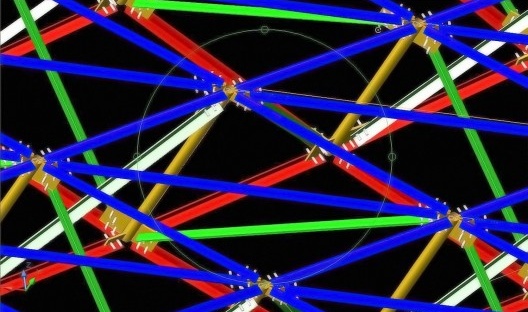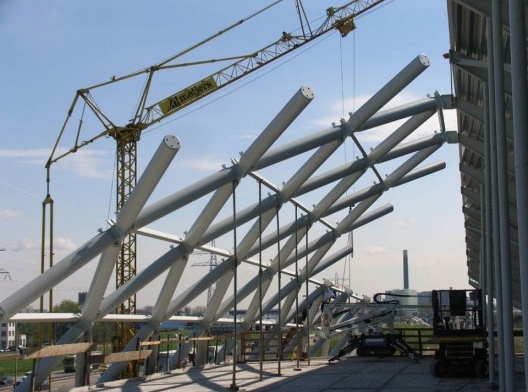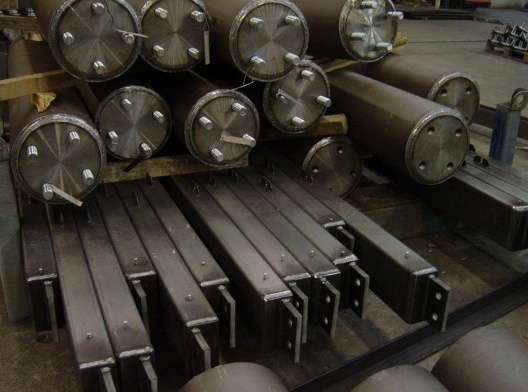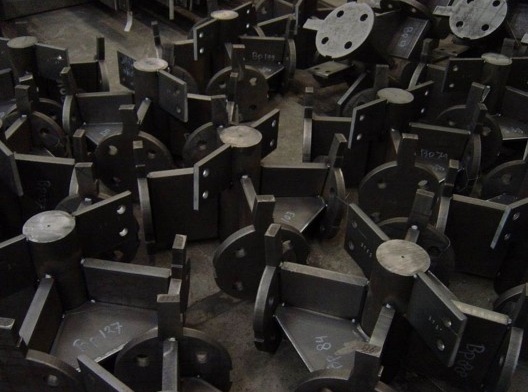MS: That is interesting because I would like to ask what you can tell about the fabrication of complex shapes. Some architects think about the fabrication and how to solve the parts after they finish the design. Do you think about it already in the beginning? How do you integrate the fabrication?
PS: All our designs are about file-to-factory production, so we integrate the thinking of about production process from the very first stages of design. I would say that is essential, if you want to create more complex shapes and different geometries. To create a certain amount of design freedom within the bandwidth of your commission, you have to understand and control the production process. We go as far, that we basically shortcut the normal building production chain, where we actually control the machines and the logistic process directly from our models with which the building is designed. So, I could show you some pictures that help to understand. For example, for the A2 cockpit what we did there is that we had a 3D model and we actually generated all the different components which are all unique in size and shape and variable throughout the whole building. It’s a 2,5km sound barrier strip and integrated into that there is a luxury car showroom, where the volume inflates in the middle of the trajectory.

Detalhe do modelo 3D [ONL]
There is a smooth transition from the sound barrier into the car showroom. Every step of the way is different, so it continually changes and every element in there is different. There is no other way then to control the production process to make that possible. There is no way that you can create that kind of variation and fluidity with traditional process, where somebody has to draw let’s say ten thousand elements or something like that. We had to set up a complete chain from the design to the production facility to be able to do that. So we directly generate the information for CNC cutting machines to produce all the steel lengths and nodes.
Basically you have a really long stretch of sound barrier that inflates and becomes this car showroom. All the complexity of the geometry is actually concentrated in the nodes, all the in between elements are all different lengths but standardized, in a sense that they are… straight.
MS: Similar?
PS: They are all unique. The logic is always similar also for the nodes. There is one parametric detail basically that allows all different kinds of angles, so that accommodates for all different positions and variables. One of the phrases we use is: “One building, one detail”, so basic you design one parametric detail that allows, adapts to the required circumstances and certain point in the building. We have one envelope that changes if it is a roof, a side, a wall or a floor, but basic is the same detail (fig 5). So we can rotate and accommodate all this changes, and that is what we did here. The nodes are all the same principles, but all the angles are always different.
MS: And about the glass, are the pieces the same size?
PS: They are all different.
MS: Are they flat?
PS: Yes. If the tessellation is fine you still get this smooth shape and sensation. And also has to do with buildings budget, making it feasible. Because curved glass is expensive and complex to make. There is also thinking about what kind of design you want to achieve, what result you are striving for and controlling or knowing what is possible in production methods. You don’t create a really crazy 3D design and then we have to use curved glass becoming too expensive. You find a method that fits within a regular building budget. This kind of buildings that we do we always stick to a stringent budget and stay within the constraints of the commission. Basically the aim is always to make sure that you, in all phases, control your parameters, which is also the budget of the building. You don’t start designing in Rhino and then at the end of the design process you say: ok now somebody else resolves all the issues and sort of throw it over the fence… Because then you get the excessive budgets and costs overruns. That is what comes to mind of people when they think of complex building and shapes; you are not so much creating a complex design but a complicated design.

Montagem do A2 cockpit [ONL]
MS: I read an article of professor Oosterhuis, he talks about the “experimental practice” approach. Do you have a research team or are you working with the university?
PS: Kas is the owner of the office and he is also a professor at TU Delft which he has his own research group, Hyperbody. There is off course some cross breeding there, where they do much about interactive environments, generative design as well, looking into new methods or possibilities of interactive architecture space, also adaptive systems. These is very much of the research is done there.
PS: He brings this experience to the office.
MS: Yes. We do research actually in every design we go into because we continuously develop new strategies to allow us to build what we want to build, what we want to design. That is actually how we also use these digital tools; basically we start programming to allow for a certain design freedom and to create the possibility to do complex shapes and different forms. It is much more about rethinking about the process then developing actual new production methods. Like in the A2 cockpit building we design this point cloud, we create a script on that which would create the geometry and you get all the information generated by the script. You get all the measures of the lengths, all elements and then we adopt an existing digital production process. All the tools that we used are already available at the factory. The only thing is that they use in a different way, we control them in a different way. A lot of these CNC machines are manually controlled, there is a guy typing in the number for radius of the bends, lengths of the elements or whatever. At that point we said: we generated all that data and we put directly into the machine and you can create a completely different way of manufacturing. Then you can make every element different, because there is not a guy who is asked to type in numbers. You can do it every iteration and then you can make a fully freeform design.
MS: The time and money you expend is almost the same to produce the pieces…
PS: That is the idea that I was talking about before, you can shortcut the chain of that traditional building process, so you start to control the production from your digital environment. It allows you to build complex designs, within a standardized budget, a standardized framework of the existing building industry in that sense.
MS: Are the numbers or tags in the pictures controlled by the software?
PS: Basically, the thinking is there should be no manual intervention. From your design file, from the digital environment that you work until the building site, there would be no manual intervention. At that point you can have an assembly like it is a Lego structure, something like that, you just connect the right numbers. That tends to work really well.

Elementos e nós [ONL]
MS: Do they have any problem/difficulty to assemble?
PS: Hardly. You also cut in the building time for this kind of thing because you have a very straight forward system of setting up your whole structure. You make sure you have the right pieces and connect together. That will form your complex shape, your full geometry.
MS: Do you have, in Netherlands, partners to use CNC machines? Is it difficult to do this partnership with the industry that never worked with architecture?
PS: I mean there is some sort of a threshold. You have to gain the confidence of the producer, that you are an architect that is able to control these kinds of data and give then correct information that they can directly produce from. At the point that you stablish that then it is very possible to do this kind of cooperation. In the Netherlands there are some companies that have this kind of machinery available and maybe they don’t know how to use it to its full potential, but they have in their workshops. When you can get access to that and get them involved in the very early stage of the process, you gain trust and confidence both ways. Then you can start to establish this kind of production process, but it is very crucial to get them involved as soon as possible to get this exchange and also the understanding of the production process. What is possible in the production line defines a lot of parameters in your system. It is important to involve them in the right way and that is the only way to be able to manipulate that. Then you know if you do something that is buildable within the framework you have. We create a lot of custom developments also within Grasshopper, we create a lot of scripting and programming in modules to allow the exchange of data and have a direct connection. But we always try to look for the simplest way of data communication, so the process becomes very lean and you only communicate what you need to. In the end for the climbing walls what we communicate is only a text file describing coordinates, and angles, and that feeds the G-code for the machine, there is small conversion, but you don’t feed the complete geometry set from a program like AutoCAD or Rhino.

Elementos e nós [ONL]



